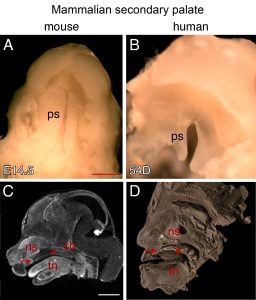 Research in the Yu lab is focused on understanding the mechanism of secondary palate morphogenesis and pathogenesis of cleft palate. Cleft palate is among the most common craniofacial malformations, affecting one in every 1000 live births worldwide. Cleft palate can be a part of genetic syndromes and also can occur as an isolated or non-syndromic birth defect that results from genetic abnormalities, environmental influences or the combination of both. The secondary palate development is a conserved morphogenetic process among mammalian species and involves of growth, elevation and fusion of two separate palatal shelves that are derived from the maxillary processes. Using mouse genetic approaches, the Yu lab has generated several mouse models that show craniofacial anomalies resembling both syndromic and non-syndromic cleft palate in humans. These mouse models will be used to test the existing paradigm of palatal morphogenesis that was built upon research conducted in the pre-molecular era and will also be used for identifying novel regulatory mechanisms of palate morphogenesis, which is essential for prevention, diagnosis and guiding treatment interventions that address cleft palate in humans.
Research in the Yu lab is focused on understanding the mechanism of secondary palate morphogenesis and pathogenesis of cleft palate. Cleft palate is among the most common craniofacial malformations, affecting one in every 1000 live births worldwide. Cleft palate can be a part of genetic syndromes and also can occur as an isolated or non-syndromic birth defect that results from genetic abnormalities, environmental influences or the combination of both. The secondary palate development is a conserved morphogenetic process among mammalian species and involves of growth, elevation and fusion of two separate palatal shelves that are derived from the maxillary processes. Using mouse genetic approaches, the Yu lab has generated several mouse models that show craniofacial anomalies resembling both syndromic and non-syndromic cleft palate in humans. These mouse models will be used to test the existing paradigm of palatal morphogenesis that was built upon research conducted in the pre-molecular era and will also be used for identifying novel regulatory mechanisms of palate morphogenesis, which is essential for prevention, diagnosis and guiding treatment interventions that address cleft palate in humans.